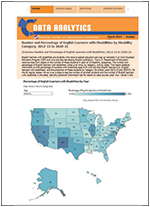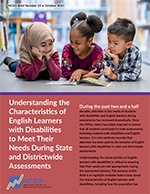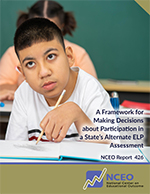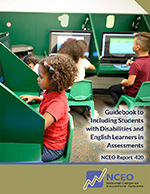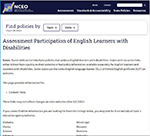Welcome
2024 greetings from NCEO. In this newsletter, we are featuring several NCEO resources that address English learners with disabilities. The number of school-age English learners with disabilities is increasing, and greater attention is being given to their inclusion in state and district assessments. The first article is about an interactive tool that allows the creation of custom reports on the number and percentage of English learners with disabilities by disability category. Other articles discuss a resource on understanding the characteristics of English learners with disabilities, a framework for the identification of students eligible for alternate English proficiency (alt-ELP) assessments, and a guidebook for states on including students with disabilities, English learners, and English learners with disabilities in assessments. There is also an article about several NCEO webpages that contain links to state assessment policies and data for English learners with disabilities.
Additionally, this issue contains an article about a recent National Council of Measurement in Education (NCME) Fireside Chat on considerations for the inclusion of students with disabilities in large-scale assessment in the past, present, and future that featured a NCEO staff member. This newsletter concludes with lists of upcoming NCEO presentations at the annual Council for Exceptional Children (CEC), American Educational Research Association (AERA), and NCME conferences.
Sheryl Lazarus, NCEO Director
Number and Percentage of English Learners with Disabilities by Disability Category
The National Center on Educational Outcomes (NCEO) recently published an interactive web-based tool, titled, Number and Percentage of English Learners with Disabilities by Disability Category, 2012-13 to 2020-21 (NCEO Data Analytics #18). This product presents information on the percentage of students with disabilities ages 6-21 who are also English learners (i.e., English learners with disabilities), and the proportion of these students for each of the 13 federal disability categories.
Understanding the Characteristics of English Learners with Disabilities
Since the 1990s, states have been mandated to ensure the inclusion of all students in assessments, including students with disabilities and English learners. English learners with disabilities are students who are in both of these groups. The National Center on Educational Outcomes (NCEO) has a brief titled Understanding the Characteristics of English Learners with Disabilities to Meet Their Needs During State and Districtwide Assessments (NCEO Brief #24) that highlights federal data on the characteristics of English learners with disabilities, and shows changes in the population over time.
A Framework for Making Decisions About Participation in a State’s Alternate ELP Assessment
A Framework for Making Decisions About Participation in a State’s Alternate ELP Assessment (NCEO Report 426), which was published by the National Center on Educational Outcomes (NCEO), offers state education agencies guidance on identifying English learners eligible for alternate English language proficiency (alt-ELP) assessments due to significant cognitive disabilities. It emphasizes the challenges in determining eligibility, particularly the interplay between language and cognitive ability.
Guidebook on Including Students with Disabilities, English Learners, and English Learners with Disabilities in Assessments
The Guidebook to Including Students with Disabilities and English Learners in Assessments (NCEO Report 420) provides 10 lessons about how to ensure inclusive assessment practices for students with disabilities, English learners, and English learners with disabilities. It is directed to state department of education staff and others interested in ensuring that assessments and assessment policies are inclusive of all students in the most appropriate ways possible.
Links to State Policies on Assessment of English Learners with Disabilities
Did you know that NCEO regularly compiles and updates information on state policies related to the assessment of English learners with disabilities? If you have questions about what states allow or how states’ policies are worded, check out the webpages.
Fireside Chat on Including Students with Disabilities in Large-Scale Assessments
The National Center on Educational Outcomes’ (NCEO’s) Andrew Hinkle gave a Fireside Chat for the National Council on Measurement in Education’s (NCME) Large-Scale Assessment Special Interest Groups in Measurement in Education (SIGIMIE) titled, Considerations for the Inclusion of Students with Disabilities in Large-Scale Assessment: Past, Present, and Future.
Upcoming NCEO Presentations at CEC, AERA, and NCME
NCEO staff will present at the annual conferences of the Council for Exceptional Children
(CEC), the National Council on Measurement in Education (NCME), and the American
Education Research Association (AERA).
The Center is supported through a Cooperative Agreement (#H326G210002) with the Research to Practice Division, Office of Special Education Programs, U.S. Department of Education. The Center is affiliated with the Institute on Community Integration at the College of Education and Human Development, University of Minnesota. Consistent with EDGAR §75.62, the contents of this report were developed under the Cooperative Agreement from the U.S. Department of Education, but do not necessarily represent the policy or opinions of the U.S. Department of Education or Offices within it. Readers should not assume endorsement by the federal government.
Project Officer: David Egnor

